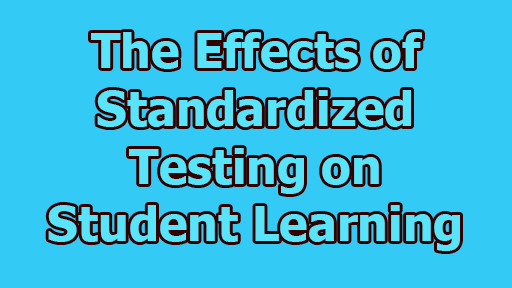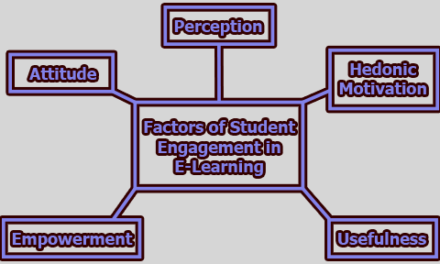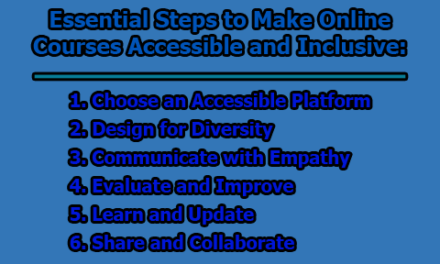The Effects of Standardized Testing on Student Learning:
In the realm of education, standardized testing has emerged as a key tool for assessing student learning outcomes and educational system effectiveness. These assessments are designed to measure students’ knowledge, skills, and abilities in a uniform manner, with the aim of providing valuable insights into their academic progress. However, the impact of standardized testing on student learning is a subject of ongoing debate. This article explores the effects of standardized testing on student learning.
Advantages of Standardized Testing:
1. Accountability and School Improvement: Standardized testing plays a pivotal role in maintaining accountability at various levels of the education system. Darling-Hammond and Adamson (2017) note that these tests offer an objective and standardized measure of student proficiency. This objectivity allows policymakers, educators, and parents to gauge the performance of schools, districts, and educational systems as a whole. When tied to performance metrics, such as Adequate Yearly Progress (AYP) in the United States, standardized testing provides a transparent mechanism for evaluating the effectiveness of schools in meeting predetermined academic benchmarks.
Moreover, the accountability fostered by standardized testing encourages schools to engage in continuous improvement. Schools that consistently achieve positive results are celebrated for their success, motivating other institutions to replicate effective strategies. Conversely, schools that fall short of expectations are prompted to identify areas for enhancement and implement targeted interventions. This accountability mechanism thus drives a culture of striving for excellence and promotes the overall betterment of the education system.
2. Data-Driven Instruction: One of the most significant advantages of standardized testing lies in its ability to facilitate data-driven instruction. Black and Wiliam (1998) emphasize that standardized test results provide educators with valuable insights into individual student performance. By analyzing these results, teachers can identify specific areas of strength and weakness for each student. This personalized understanding of student needs enables educators to tailor their instructional strategies accordingly.
The data-driven approach allows educators to implement targeted interventions, such as additional support or enrichment activities, based on the specific areas in which students require assistance. As a result, students benefit from instruction that is attuned to their learning needs, leading to improved learning outcomes. Moreover, the longitudinal nature of standardized testing data enables educators to track student progress over time and assess the effectiveness of interventions, ensuring that instructional approaches remain adaptive and impactful.
3. Curriculum Alignment: Standardized testing often serves as a guiding force for curriculum alignment and development. Popham (2005) highlights that these assessments outline the essential skills and knowledge that students are expected to acquire. Educators can utilize this framework to structure their lesson plans and teaching materials, ensuring that students are adequately prepared for the assessments.
Curriculum alignment with standardized tests has several benefits. First, it promotes a cohesive educational experience, as students across different schools or districts are exposed to similar content. This consistency helps to standardize the quality of education and ensures that all students have access to fundamental concepts and skills. Second, alignment supports educators in structuring their teaching plans effectively. By adhering to the content covered by standardized tests, teachers can allocate appropriate time to various topics, thereby enhancing instructional efficiency.
Disadvantages of Standardized Testing:
1. Narrowed Curriculum: One of the primary concerns associated with standardized testing is the potential for a narrowed curriculum. Au (2007) identifies the phenomenon of “teaching to the test,” wherein educators prioritize content that aligns directly with the test’s scope and format. This teaching approach may lead to a restricted focus on topics and skills directly assessed by the test, sidelining other valuable subjects and areas of learning.
As educators concentrate on preparing students to perform well on the standardized test, they may inadvertently neglect broader educational objectives, such as fostering critical thinking, creativity, and problem-solving skills. This narrowing of the curriculum can result in an incomplete and shallow educational experience for students, depriving them of the well-rounded knowledge and skills required for holistic development.
2. Impact on Teaching Quality: Another notable disadvantage of standardized testing pertains to its potential impact on teaching quality. Amrein-Beardsley and Collins (2012) highlight the concern that the pressure to achieve high test scores can lead to a focus on test preparation strategies, overshadowing the importance of fostering deep understanding and critical thinking skills. Educators may feel compelled to prioritize short-term gains in test performance over the cultivation of students’ long-term intellectual growth.
This shift in priorities can lead to teaching practices that prioritize memorization and rote learning techniques over meaningful engagement with subject matter. As a result, students may graduate with a surface-level understanding of concepts rather than the ability to apply knowledge in complex and real-world contexts. This erosion of teaching quality has the potential to undermine the ultimate goal of education: to equip students with skills that transcend the confines of standardized assessments.
3. Stress and Anxiety: The high-stakes nature of standardized testing can have detrimental effects on student well-being. Putwain and Remedios (2014) conducted a study that revealed a clear link between test-related anxiety and performance outcomes. The pressure to excel on a single assessment can induce significant stress and anxiety in students, adversely affecting their cognitive functioning and test performance.
This heightened stress may lead to a range of negative outcomes, including decreased motivation, impaired concentration, and compromised overall mental well-being. Students who experience intense test-related anxiety may struggle to perform at their best, despite their actual knowledge and capabilities. Moreover, the emphasis on standardized test scores as a measure of success can contribute to a narrow definition of achievement, potentially overlooking other valuable aspects of a student’s growth and potential.
4. Limited Assessment Scope: Critics also contend that standardized testing tends to focus on a limited scope of subjects and skills, overlooking the full spectrum of students’ abilities. Shepard (2000) highlights the concern that standardized tests may fail to capture important attributes such as creativity, collaboration, and practical problem-solving skills. As a result, students’ diverse talents and potential may go unrecognized and undervalued.
Furthermore, the restricted assessment scope may drive educators to prioritize subjects covered by the tests at the expense of other equally important disciplines. This can perpetuate an imbalanced educational experience, where certain subjects are underemphasized, leading to a skewed development of students’ intellectual and practical capacities.
Balancing Act: Navigating Standardized Testing to Optimize Student Learning:
i. Alternative Assessment Methods: Enhancing Depth and Diversity: A pivotal strategy in addressing the limitations of standardized testing is the incorporation of alternative assessment methods. While standardized tests excel in quantifying specific knowledge and skills, they often fall short in evaluating attributes like creativity, critical thinking, and practical application. To counteract this, educators can integrate project-based evaluations, portfolios, and performance assessments into their evaluation toolkit. Darling-Hammond and Adamson (2017) advocate for a balanced assessment approach that encompasses both standardized tests and performance-based evaluations. This comprehensive approach enables educators to gain a more holistic view of students’ capabilities, encouraging a multifaceted understanding of their strengths and areas for improvement.
ii. Professional Development for Educators: Cultivating Quality Instruction: Mitigating the pitfalls of “teaching to the test” requires investing in the professional development of educators. Amrein-Beardsley and Collins (2012) emphasize the importance of equipping teachers with strategies that align with both standardized testing requirements and broader educational objectives. Professional development programs can empower educators to integrate test preparation seamlessly into their teaching methods without sacrificing the depth and quality of learning experiences. This involves fostering an environment that encourages critical thinking, problem-solving, and the exploration of diverse perspectives, even within the framework of standardized testing.
iii. Holistic Approach to Curriculum: Beyond the Test’s Boundaries: The concern of curriculum narrowing can be effectively addressed through a holistic approach to curriculum design. Popham (2005) highlights that educators can harmonize standardized testing content with broader educational goals by incorporating interdisciplinary approaches and real-world applications. By infusing creativity, exploration, and practical problem-solving into the curriculum, educators can nurture a genuine passion for learning that extends beyond the confines of standardized assessments. This approach not only enriches students’ educational experiences but also equips them with the skills required for success in an ever-changing world.
iv. Mindful Preparation and Support: Alleviating Test-Related Stress: Elevated stress and anxiety levels associated with standardized testing require proactive measures to mitigate their impact. Schools can implement comprehensive strategies to prepare students mentally and emotionally for high-stakes assessments. This includes providing students with a clear understanding of the purpose and format of the tests, along with effective stress-management techniques. Collaboration among educators, parents, and administrators is crucial in creating a supportive environment that fosters student well-being and minimizes the negative effects of test-related stress (Putwain & Remedios, 2014).
v. Ongoing Research and Policy Refinement: A Dynamic Approach: Striking a balance between the advantages and disadvantages of standardized testing necessitates an ongoing commitment to research and policy refinement. Shepard (2000) underscores the importance of continually evaluating and adapting assessment methods to align with evolving educational goals. Policymakers, educators, researchers, and stakeholders must engage in an active dialogue to ensure that standardized testing remains effective, relevant, and responsive to the needs of students and society. Regular review and adjustment of assessment strategies enable educational systems to navigate the complexities of standardized testing while ensuring optimal learning outcomes.
In conclusion, the effects of standardized testing on student learning unfold as a complex interplay between advantages such as accountability, data-driven instruction, and curriculum alignment, and challenges encompassing a narrowed curriculum, compromised teaching quality, heightened stress, and limited assessment scope. Striking a delicate balance between these facets demands a thoughtful approach that integrates alternative assessment strategies, encourages professional development, advocates for a holistic curriculum, and provides robust support mechanisms. This intricate journey towards optimized education necessitates continuous research, collaborative efforts, and adaptive policies, shaping standardized testing into a dynamic force that propels holistic student growth and learning possibilities beyond boundaries.
Frequently Asked Questions (FAQs):
What is standardized testing, and why is it used in education?
Standardized testing is a method of assessing students’ knowledge, skills, and abilities using uniform test formats and scoring criteria. It is employed in education to measure student performance objectively, compare outcomes across schools or districts, and inform educational policies and decision-making.
What are the advantages of standardized testing?
Standardized testing offers several advantages, including accountability by evaluating school and district effectiveness, data-driven instruction through insights into individual student strengths and weaknesses, and curriculum alignment by guiding educational content development.
How does standardized testing impact teaching quality?
Standardized testing can influence teaching quality by pressuring educators to focus on test preparation strategies rather than fostering deep understanding and critical thinking. This shift may compromise the overall quality of education as teaching priorities lean towards short-term test performance.
What challenges are associated with standardized testing?
Standardized testing can lead to a narrowed curriculum, where educators prioritize content aligned with the tests, potentially excluding other valuable subjects. Additionally, students may experience stress and anxiety due to the high-stakes nature of testing, and the limited assessment scope may not capture the full range of their abilities.
How can educators address the limitations of standardized testing?
Educators can mitigate the drawbacks of standardized testing by incorporating alternative assessment methods such as project-based evaluations and portfolios. They can also focus on professional development to balance teaching for test preparation with fostering critical thinking and deeper understanding.
How does standardized testing impact student well-being?
High-stakes standardized testing can contribute to heightened stress and anxiety among students, affecting their cognitive functioning and overall well-being. Strategies such as stress-reduction techniques and supportive environments can help alleviate these negative effects.
Is there a way to balance the benefits and challenges of standardized testing?
Yes, achieving a balance involves implementing a holistic curriculum that goes beyond test requirements, supporting educators’ professional development, and providing students with a well-rounded education. Collaborative efforts among educators, policymakers, and researchers are essential for refining assessment practices and maintaining a dynamic approach.
How can standardized testing evolve in the future?
Standardized testing can evolve by embracing innovative assessment methods that assess a wider range of skills, fostering a deeper understanding of subjects, and focusing on students’ overall growth and development. Continuous research and adaptation of assessment policies are crucial to its ongoing improvement.
What is the role of policymakers in optimizing standardized testing’s effects?
Policymakers play a vital role in ensuring that standardized testing serves its purpose effectively. They should engage with educators, researchers, and stakeholders to refine assessment strategies, address challenges, and create a balanced framework that promotes both accountability and student development.
What’s the ultimate goal of standardized testing in education?
The ultimate goal of standardized testing is to provide an objective measure of student learning outcomes, inform educational policies, and support continuous improvement. However, the broader goal is to utilize testing as a tool for enhancing student learning experiences, nurturing critical thinking, and preparing students for success in a diverse and evolving world.
References:
- Amrein-Beardsley, A., & Collins, C. (2012). The SAS Education Value-Added Assessment System (EVAAS) in the Houston Independent School District (HISD): Intended and Unintended Consequences. Educational Policy Analysis Archives, 20(12), 1-41.
- Au, W. (2007). High-stakes testing and curricular control: A qualitative metasynthesis. Educational Researcher, 36(5), 258-267.
- Black, P., & Wiliam, D. (1998). Inside the black box: Raising standards through classroom assessment. Phi Delta Kappan, 80(2), 139-148.
- Darling-Hammond, L., & Adamson, F. (2017). Beyond Basic Skills: The Role of Performance Assessment in Achieving 21st Century Standards of Learning. Stanford Center for Opportunity Policy in Education.
- Popham, W. J. (2005). Test Better, Teach Better: The Instructional Role of Assessment. Association for Supervision and Curriculum Development.
- Putwain, D. W., & Remedios, R. (2014). The effects of test‐related anxiety on attentional allocation, cognitive performance and mood. British Journal of Psychology, 105(3), 443-458.
- Shepard, L. A. (2000). The role of assessment in a learning culture. Educational Researcher, 29(7), 4-14.

Former Student at Rajshahi University










